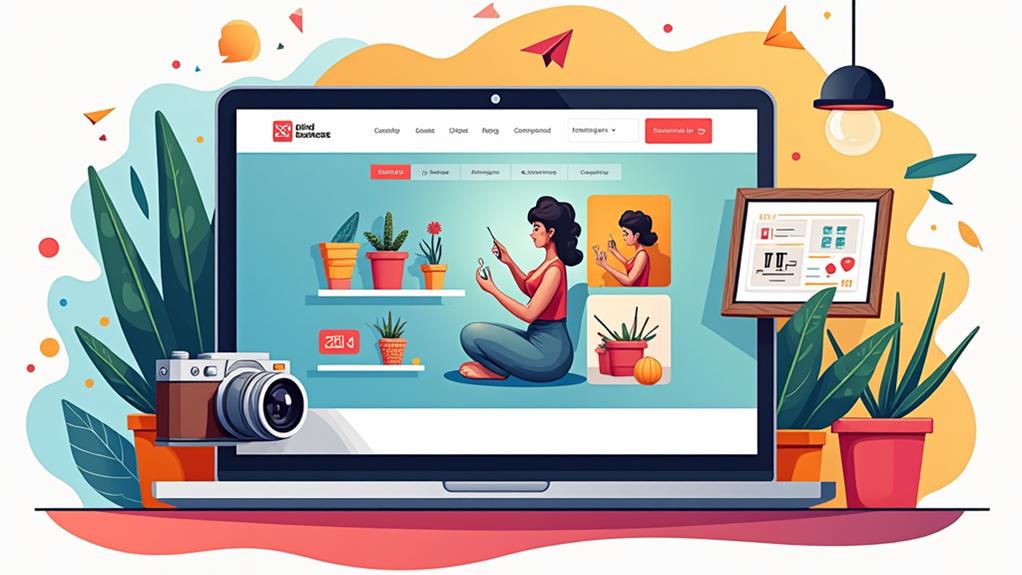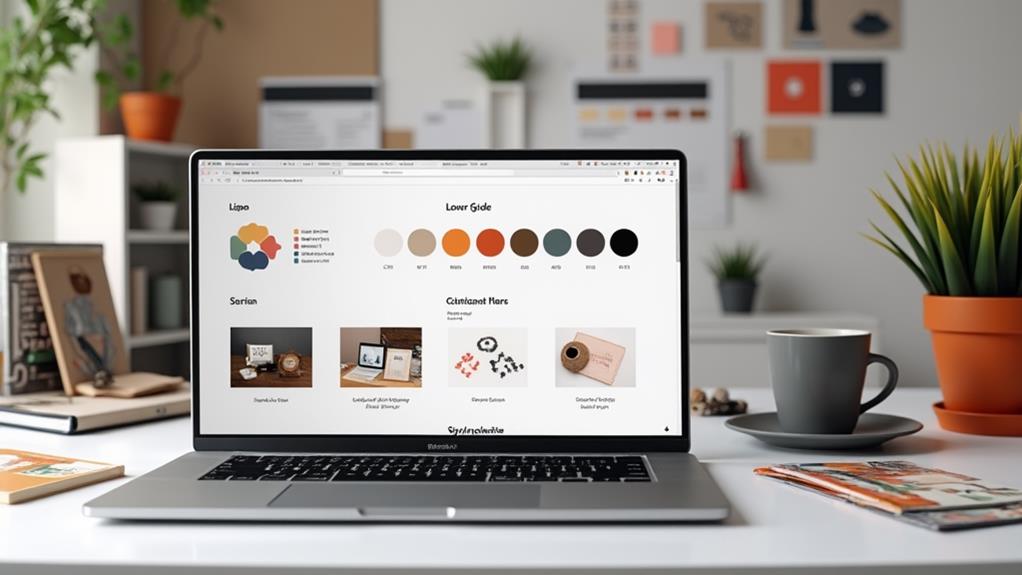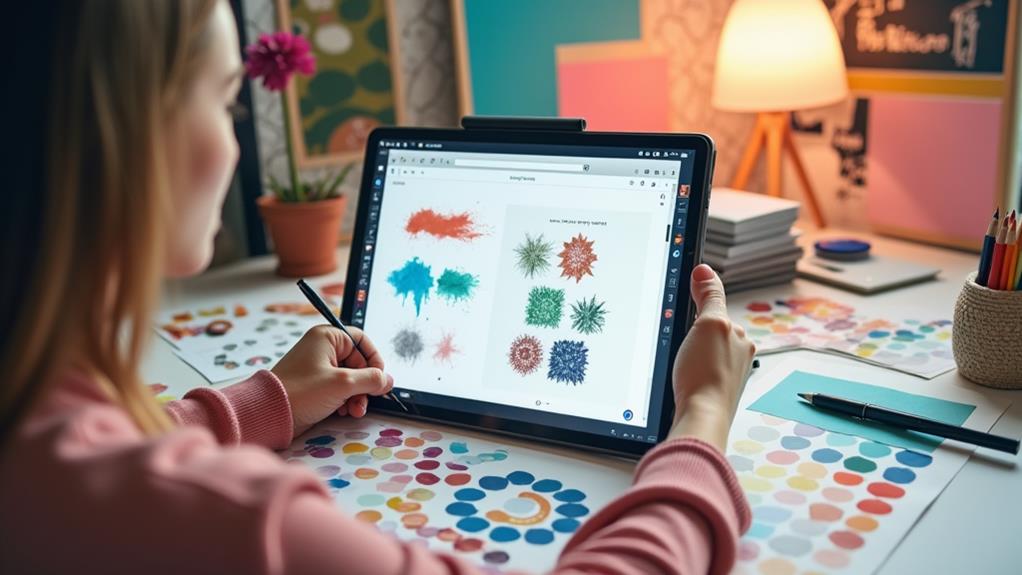In 2024, small businesses should prioritize five key website design trends to boost user experience. Embrace innovative navigation techniques like full-screen and in-image navigation to create unique, immersive interactions. Consider typography that is both structured and kinetic, adding movement to enhance message delivery. Incorporate animation and motion design, such as micro-interactions, to engage users dynamically. Nostalgic design elements can evoke emotional connections, fostering brand loyalty. Additionally, implementing sustainable web practices not only aligns with environmental values but also improves site performance. These trends help businesses capture attention and can offer deeper insights into enhancing their digital strategies.
Key Takeaways
- Full-screen navigation offers an immersive experience, focusing user attention on key content elements.
- Kinetic typography engages users with animated text, enhancing message delivery and interaction.
- Nostalgic design elements evoke emotional connections, fostering brand loyalty and user engagement.
- Sustainable web practices, like eco-friendly hosting, position brands as environmentally responsible leaders.
- Scroll-triggered animations dynamically guide user navigation, improving storytelling and site interaction.
How can small businesses enhance their website's user experience in a digital landscape teeming with competition? The answer lies in adopting innovative navigation techniques that leverage dynamic interfaces to boost user engagement.
As traditional text links become outdated, full-screen navigation emerges as a powerful alternative. By immersing users in a visually enthralling experience, it facilitates smooth shifts and keeps their attention focused on the content.
Scroll navigation, another cutting-edge approach, dynamically introduces buttons and links as users scroll through the page. This feature not only enhances content discovery but also encourages interaction, making the browsing experience both seamless and engaging.
In addition, in-image navigation utilizes intuitive icons and visual cues, guiding users through the website with ease and enhancing overall usability.
Experimental navigation techniques offer unique layouts that subvert conventional styles, inviting users to explore content in novel ways. Such designs can greatly enhance user engagement by fostering a sense of curiosity and discovery.
Custom navigational elements, tailored to reflect a brand's personality, further solidify a distinctive user journey. For small businesses, these innovative navigation strategies not only enhance digital presence but also create memorable interactions that resonate with users.
Typography and Visual Appeal
In 2024, typography and visual appeal are pivotal in shaping the digital landscape for small businesses, with several dynamic trends leading the charge. Kinetic typography is at the forefront, leveraging movement and animation to not only capture attention but also enhance user engagement. This dynamic approach allows small businesses to convey messages with energy and precision, transforming static text into an interactive experience.
Complementing this is structured typography, which emphasizes bold letters and clear visual hierarchies. This trend caters to a consumer preference for stability and readability, ensuring that information is accessible and easily digestible.
Text-only design is gaining traction, embracing minimalism by focusing on concise text delivery to reduce visual clutter. This approach effectively delivers impactful messages without overwhelming the user, aligning with the growing desire for simplicity.
Goofy sans serif typography is emerging as a favorite for brands targeting younger audiences, offering a playful yet approachable identity. Meanwhile, gradients have evolved beyond subtlety, now serving as bold backgrounds that add depth and texture to typography.
These elements collectively enhance the visual appeal of websites, offering a rich and engaging user experience that aligns with contemporary digital aesthetics.
Animation and Motion Design
Animation and motion design are transforming the way small businesses engage with their digital audiences, offering a visually compelling and interactive user experience. By incorporating dynamic elements, businesses can create a more engaging online presence.
Micro interactions, for instance, play an essential role in enhancing user engagement by offering feedback during interactions, thereby making the browsing journey intuitive and enjoyable. These subtle animations are not just decorative but functional, guiding users seamlessly through tasks.
Animated storytelling is another powerful tool, utilizing animated illustrations to convey complex ideas effectively. This method not only simplifies communication but also leaves a lasting impression on visitors, enhancing brand recall.
Additionally, the use of cinemagraphs—those high-quality videos or GIFs—injects movement into otherwise static web pages, effectively capturing attention and encouraging longer visits.
Consider the following techniques for integrating animation and motion design:
- Micro-Animations: Enhance user engagement by providing feedback during interactions.
- Cinemagraphs: Add dynamic movement to static pages, capturing attention.
- Kinetic Typography: Merge visual storytelling with written communication, grabbing attention.
- Scroll-triggered animations: Guide users through the site dynamically, enhancing narrative flow.
Incorporating these elements can greatly improve a website's user-centric design, turning browsers into engaged participants.
Nostalgic Design Elements
Building on the dynamic allure of animation and motion design, nostalgic design elements offer another layer of engagement by tapping into the emotional reservoir of collective memories. In 2024, these elements, particularly Y2K aesthetics, evoke playful memories of the late 90s and early 2000s. This trend is appealing to younger audiences who find familiarity in these vibrant, tech-infused visuals.
Incorporating Y2K aesthetics involves the strategic use of bright color palettes, retro fonts, and pixelated graphics, which collectively create a sense of playful nostalgia on digital platforms.
Additionally, the evolution of scrapbook visuals merges traditional nostalgia with digital modernity. By integrating tactile, collage-like designs with fluid digital elements, brands can captivate users with a fresh yet familiar experience. This approach allows for a dynamic interactive experience that can notably enhance brand identity and user engagement.
Meanwhile, the resurgence of retro and Memphis design trends, with their bold colors and geometric patterns, captures attention and celebrates past design movements. These nostalgic elements not only resonate with users seeking authenticity but also foster emotional connections, thereby fostering brand loyalty across diverse demographics.
For small businesses, this offers a strategic advantage in a competitive digital landscape.
Sustainable Web Practices
As businesses increasingly pivot towards digital solutions, sustainable web practices come to the forefront as an integral strategy for reducing environmental impact.
Eco-friendly hosting stands out as a vital choice, reducing a website's carbon footprint by leveraging renewable energy and minimizing energy consumption. This shift is not merely ethical but also strategic, aligning with consumer preferences and sustainability goals.
Efficient coding plays an important role in this paradigm. By streamlining website code, developers can enhance performance while greatly cutting down server load. This not only benefits the environment through reduced energy usage but also guarantees a seamless user experience.
A minimalist design approach further complements these sustainable practices. By focusing on simplicity, websites can achieve faster loading times and reduced data transfer, both of which contribute to a greener digital footprint.
To effectively implement these strategies, businesses can utilize various tools to monitor and optimize website performance. These tools help identify areas for improvement, enabling data-driven decisions that align with environmental objectives.
- Eco-friendly hosting: Utilizes renewable energy
- Efficient coding: Reduces server load, enhancing performance
- Minimalist design: Accelerates loading times
- Performance monitoring tools: Identify areas for sustainability improvement
Aligning brand values with such initiatives not only cultivates customer loyalty but also positions businesses as leaders in environmental responsibility.
Frequently Asked Questions
What Is the Future of Web Design in 2024?
In 2024, web design will prioritize user experience through responsive design, incorporating immersive 3D elements and kinetic typography. A focus on headless CMS and sustainability will further enhance performance, flexibility, and eco-friendliness in creating engaging, user-centric interfaces.
What Is the Next Big Thing in Web Design?
The next big thing in web design involves combining immersive experiences with minimalist aesthetics, creating visually enchanting, technically advanced, and user-centric platforms that prioritize seamless interaction, reducing complexity while enhancing user engagement through innovative, interactive, and streamlined design elements.
What Is the Future of Website Design?
The future of website design focuses on enhancing user experience through minimalist design, utilizing AI for personalization, and integrating immersive technologies like AR for interactive interfaces. Prioritizing accessibility and sustainability, these advancements cater to diverse user needs and preferences.
Which Type of Website Is Now Trending?
Currently, minimalist designs integrated with interactive elements are trending. This approach focuses on user-centric, visually appealing aesthetics, enhancing engagement through clean layouts combined with dynamic features, thereby providing a seamless and immersive experience for modern website visitors.
Conclusion
In 2024, website design for small businesses will be defined by innovative navigation techniques, which streamline user experiences, and typography that enhances visual appeal. Animation and motion design will engage users, creating dynamic interactions. Nostalgic design elements will evoke familiarity and emotional connections. Sustainable web practices will reflect a commitment to environmental responsibility. These trends collectively emphasize a user-centric approach, focusing on aesthetics, functionality, and sustainability, thereby enhancing the overall digital presence of small businesses.




